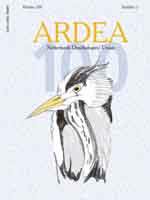For a long time, agricultural areas had considerable ornithological value, an ecological richness which in The Netherlands was epitomised by the term ‘meadow birds’. However, over the last half century, agricultural intensification has negatively affected the quality of meadow bird habitats. Here we provide a quantitative characterization of agricultural habitats and their use by Blacktailed Godwits Limosa I. limosa in the south-western part of the province of Friesland, The Netherlands, in 2009, to provide a yardstick to evaluate further change. We used groundwater level, vegetation typology, relief in the landscape, the occurrence of foot drains, land use and soil characteristics such as textures and peat to describe the landscape that comprised 43 polders covering 8480 ha. We used a Principal Component Analysis to summarize landscape characteristics and find that much of the habitat variation is explained by a combination of herb richness of the vegetation, the presence or absence of foot drains and groundwater level. The modern agricultural landscape of southwest Friesland consists of 80% of uniform, intensively managed landscape with herb-poor meadows and low groundwater levels, the remaining 20% being taken by remnants of the former herb-rich meadows. The whole study area was searched weekly and Black-tailed Godwits were mapped between arrival and egg-laying. The positive relationship between godwit density and the first PC axis indicates that Black-tailed Godwits preferred herb-rich polders with high groundwater levels and the presence of foot drains. Soil texture was poorly correlated with godwit breeding densities for intensively managed (herb-poor) parcels, but for herb-rich meadows, soils of sandy clay loam and sandy clay harboured the highest densities of godwits. To protect Black-tailed Godwits, areas should have a herb-rich vegetation, contain foot drains and high groundwater tables should be re-established.
How to translate text using browser tools
1 April 2012
A Modern Landscape Ecology of Black-Tailed Godwits: Habitat Selection in Southwest Friesland, The Netherlands
Niko M. Groen,
Rosemarie Kentie,
Petra de Goeij,
Bram Verheijen,
Jos C.E.W. Hooijmeijer,
Theunis Piersma

Ardea
Vol. 100 • No. 1
April 2012
Vol. 100 • No. 1
April 2012
bird conservation
fragmentation
habitat quality
habitat selection
meadow bird
PCA
soil characteristic




